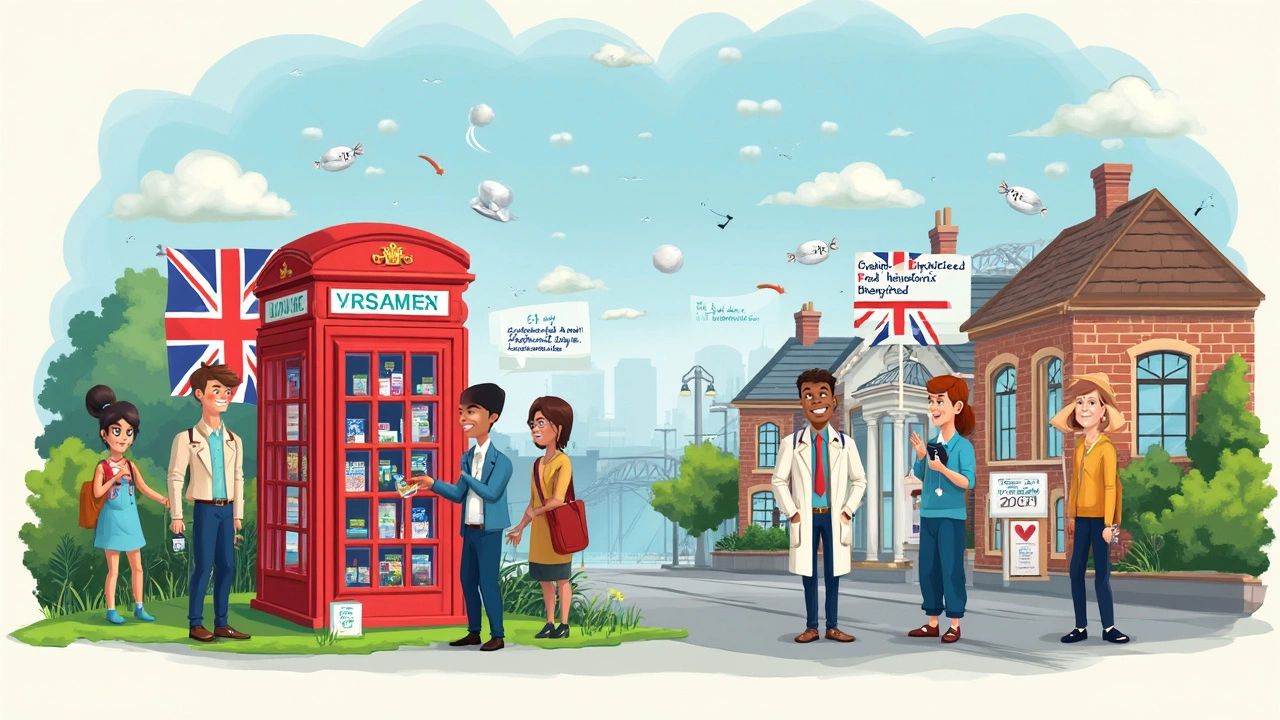 Jun, 12 2025
Jun, 12 2025
People love to argue about which country does healthcare better—the UK or the US. If you’ve ever tried to make sense of National Health Service (NHS) waiting lists or stared down a $1,500 hospital bill in the States, you know there’s no simple answer.
What really matters? How much you pay, how you get seen, and what happens when you need help fast. A lot of folks moving between these two countries end up surprised—or downright shocked—by how differently things work. Let’s kick things off with a straight-up comparison so you actually know what to expect, whether you’re swapping your NHS card for private insurance, or vice versa. Spoiler: It’s not just about the money (though, yeah, that’s a big part).
- How Healthcare Works: UK vs US
- What You Pay: Costs and Insurance
- How Easy Is It to Get Care?
- Quality and Patient Experiences
- Tips for Navigating Healthcare Systems
How Healthcare Works: UK vs US
On the surface, both countries offer doctors, hospitals, and treatments. But the rules of the game couldn’t be more different. In the UK, the National Health Service (NHS) covers almost everybody, and it’s mostly paid through general taxes. Walk into a GP clinic or emergency room? No bill shows up at your door afterwards. In the US, it’s way more complicated. There’s no single public system for everyone, and your access depends a lot on if (and how) you’re insured.
Most people in the UK use the NHS for their healthcare needs. There’s private healthcare too, but only about 12% of Brits have private insurance, usually to dodge long wait times. In contrast, in the US, nearly everyone either gets private insurance (often through their employer), buys a plan themselves, or qualifies for public programs like Medicare (mainly for those over 65) or Medicaid (for some low-income folks). The rest—about 7% of Americans in 2024—don’t have any insurance at all.
Here’s a quick healthcare UK vs US stats rundown for 2024:
| UK - NHS | US | |
|---|---|---|
| Coverage | 98% (universal) | 93% (non-universal) |
| Main Funding | General taxation | Private insurance, employers, federal/state taxes |
| Out-of-pocket costs | Low (prescriptions capped, most services free) | High (deductibles, co-pays, bills) |
| Admin Costs (of total health spend) | <2% | >8% |
| Avg. annual spend per person | £3,200 | $13,500 |
The UK’s system is often easier to understand—you’re in, you’re covered. The US system is a maze of paperwork and terms: premiums, deductibles, in-network, out-of-network, pre-approvals. Luckily, both countries have some government help, but how much you pay (and how protected you feel) will be very different depending on the country—and your situation.
What You Pay: Costs and Insurance
If you want to know the biggest difference between healthcare in the UK and US, it hits your wallet first. In the UK, most people never see a bill for seeing a doctor or staying in hospital because the NHS takes care of it. You pay for it through taxes, not at the clinic. Basically, everyone pays a slice into the system, and you get most things covered, including surgery, emergencies, and GP visits.
Private insurance does exist in the UK, but only about 10% of people use it—usually for faster access or extra comfort. Even if you go private, costs are tame compared to the States. Most folks stick with the NHS because it covers the essentials for free at the point of use.
Hop over to the US, and the story flips. Here, healthcare is mostly run by private companies. Insurance is expensive, confusing, and full of odd rules. If your job offers insurance, they might cover a big chunk, but you’ll still get monthly premiums. In 2024, the average insurance premium for a family was around $1,500 per month. That’s before you even see a doctor.
And it gets more complicated. US insurance usually comes with deductibles—money you pay before your plan even kicks in. Plus, co-pays pile up for every visit or prescription. If you lose your job, insurance can vanish overnight. For the unlucky without insurance, costs are eye-watering. A single ER visit with no coverage can mean a bill for thousands.
Just to make it clear, here’s how it shakes out for your pocket:
- Healthcare UK: No direct upfront costs for most care. Funded by taxes. Private insurance is optional.
- Healthcare US: High out-of-pocket payments unless you’re covered. Expensive insurance plans. Biggest cause of personal bankruptcy in the country is medical bills.
If you’re moving from the UK to the US, don’t wait to get insurance sorted—seriously. If you’re going the other way, you might be able to drop your private plan and go straight onto the NHS, saving a boatload. The systems expect you to play by very different rules, so staying covered takes planning.

How Easy Is It to Get Care?
This is where things really start to look different. In the UK, you can walk into a doctor’s office (GP surgery) and not worry about the bill, thanks to the healthcare UK system. But don't expect instant appointments. Getting a same-day or next-day GP slot is rare unless it’s an emergency, and referrals to specialists can mean weeks or even months of waiting. On the flip side, if it’s urgent—like chest pain or a broken leg—A&E (the UK ER) will treat you fast, and you’ll never pay out of pocket at the point of care.
In the US, speed is often the perk—if you’ve got good insurance. You can usually schedule specialist visits within days, and even tests or scans happen fast. The snag? Your wallet. Without insurance, or even with a high-deductible plan, just seeing a doctor might set you back a couple hundred dollars. And ER visits can bankrupt people without coverage. For non-critical stuff, it’s all about what your insurance lets you do. Some plans require pre-approval or only cover a small network of doctors.
Take a look at how wait times stack up on average:
| Type of Care | UK Average Wait | US Average Wait |
|---|---|---|
| Primary Care Appointment | 8-10 days | 6-9 days |
| Specialist Referral | Up to 18 weeks (NHS target)* | Less than 3 weeks (with insurance) |
| Emergency Care | 2-4 hours wait in A&E | Less than 1 hour in most ERs |
*In 2024, the NHS target was an 18-week maximum wait from referral to treatment, but nearly half of patients actually waited longer.
If you like the idea of being seen quickly, the US system looks good on paper, but only if your insurance is up to scratch. In the UK, nobody is turned away for lack of cash, but patience is often part of the deal. One practical tip: in the UK, calling your GP’s office first thing in the morning boosts your chances of getting a same-day appointment. In the US, always double-check what’s covered before booking anything—surprise bills are never fun.
Quality and Patient Experiences
Let’s be real: healthcare isn’t just about paying your bill or signing up for a plan. It’s about how you’re actually treated when you show up sick, stressed, or scared. That’s where things get interesting between the UK and US.
In the UK, the National Health Service (NHS) keeps things simple. No need to juggle insurance paperwork or fight over treatment approval. About 90% of Brits rate their NHS experience as "satisfactory" or "very satisfactory," and you’ll never face bankruptcy for falling ill. But the trade-off? Wait times can be a pain, especially for non-urgent stuff. For example, in 2024, NHS England reported that about 38% of patients waiting for elective surgeries had to hang around for more than 18 weeks. That’s a long time if you’re stuck waiting for a knee replacement or cataract surgery.
In the US, things move faster—if you can pay for it or have great insurance. You’ll often schedule that specialist appointment in days, not months. Hospitals have cutting-edge tech, and you get more choice about which doctor you see. But the downsides are obvious: costs are sky-high, and medical bills can snowball into huge debt. A 2023 study from the Kaiser Family Foundation found that nearly 41% of American adults were saddled with medical or dental bills they couldn’t pay off.
Here’s what Dr. Atul Gawande, a well-known surgeon and writer, says about comparing the two systems:
“The NHS guarantees that everybody gets care, though not always quickly, and doesn’t bankrupt anyone. The U.S. system gives you access to world-class care right away — if you can afford it, and if your insurance company agrees.”
So, what’s it like on the ground? In the UK, you’ll get the care you need, eventually, and you never worry about being turned away for lack of cash. But be ready to wait for anything that isn’t urgent. In the States, you can get rapid access, but you might end up fighting with insurance companies or dreading the bill in your mailbox. This is where the healthcare UK vs US debate heats up: Would you rather wait longer but pay less, or pay more and jump the line?
- If you’re moving to the UK, get used to the word “queue.” It’s not personal—it’s just how the NHS tries to manage limited resources fairly.
- US residents should double-check what their insurance actually covers. Don’t assume a fancy plan pays for everything. Always ask about out-of-pocket costs before agreeing to treatments or procedures.
There’s no one-size-fits-all answer. Your experience depends on where you live, how sick you are, and what you can afford—or what you’re willing to put up with. The bottom line? Both systems have strengths and flaws. It’s mostly about what’s more important to you: lower costs and universal coverage, or speed and more choices but higher risk of bills.

Tips for Navigating Healthcare Systems
Switching countries can be wild when it comes to figuring out healthcare. There’s paperwork, waiting lines, costs you didn’t see coming, and even simple things like how to register with a doctor feel like decoding a secret language. Here’s how to make life easier whichever side of the pond you’re on.
- Healthcare UK: If you’re moving to the UK, the first thing is to register with a local General Practitioner (GP). You’ll need proof of address, and sometimes even a utility bill. Without a GP, you’re locked out of routine appointments and repeat prescriptions.
- Make sure you know what’s actually covered. The NHS handles most things, but dental and vision are rarely free for adults. Prescriptions are capped—£9.90 per item in England in 2025—but different rules for Scotland, Wales, and Northern Ireland, where it’s usually free.
- For the US, always check your insurance network before seeing a doctor. Go ‘out-of-network’ and you might be slammed with huge bills. Choose your primary care physician through the insurance provider—don’t just walk into any clinic.
- It’s smart to keep emergency numbers handy: 999 in the UK, 911 in the US. And don’t forget, urgent care clinics in the US can be way cheaper than hospital emergency rooms for minor stuff.
Confused about how much stuff costs? Here’s a quick comparison.
| Service | UK (NHS/Avg 2025 GBP) | US (Insurance/Avg 2025 USD) |
|---|---|---|
| Primary Care Visit | Free at point of use | $130-$200 without insurance |
| Prescription | £9.90 per item (England) | $10-$50 copay (insurance), up to $120+ without |
| Dental Check-Up | £25.80 (NHS Band 1) | $100-$350 (without dental insurance) |
| Ambulance Ride | Usually free | $500-$1,200+ |
Planning ahead makes a big difference. Whether you stick with the NHS or navigate the maze of US insurance, keep your paperwork in one place, ask questions, and get familiar with what your plan does and doesn’t cover. That way, you’re less likely to get hit with surprises when you need care the most.
